Last Updated on July 20, 2024 by Kittredge Cherry

Some see the prophet Daniel and the chief eunuch Ashpenaz as a same-sex couple. In a hotly contested translation, the Bible describes the “favor and tender love” that he bestowed on Daniel.
LGBTQ people find role models in Bible stories about eunuchs, including the prophet Daniel. In the Hebrew scriptures, Daniel and his three friends Shadrach, Meshach and Abednego, who may all have been eunuchs, all refused a king’s orders to stop worshiping God, and were miraculously rescued from execution. Daniel survived being thrown into a den of lions. The young men Shadrach, Meshach and Abednego were thrown into a fiery furnace, but a Christ figure “like a son of God” prevented them from burning.
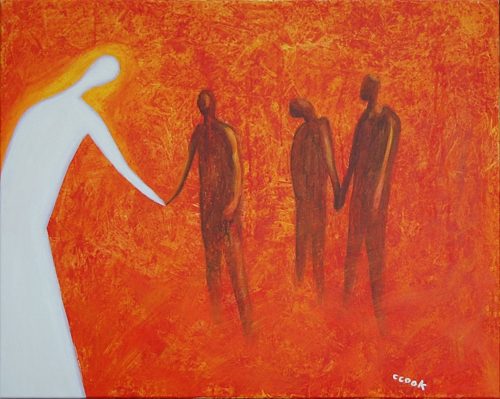
“Shadrach, Meshach and Abednego” by Chris Cook.
Chapter 10 in the Bible’s Book of Daniel is also open to gay interpretations of the relationship between Daniel and the supernatural man (or angel?) who appears to him in a vision and whose “hand touched me and made my hands and knees shake.” Homoerotic interpretations of Jacob wrestling with the angel are more common, but could also apply here.
Daniel is commemorated on July 21 in the Roman Catholic tradition, while Dec. 16 is the feast day for the three young men. In the Orthodox church Dec. 17 is the feast day for Daniel and the three young men.
The term translated as “eunuch” needs to be decoded to find the queer figures who are buried in the Bible. The Bible strongly implies that Daniel was a eunuch without saying so directly. He and the three young men were under the authority Ashpenaz, the chief of the eunuchs in the King Nebuchadnezzar’s court. Daniel 1:9 (King James version) says, “Now God had brought Daniel into favor and tender love with the prince of the eunuchs.”
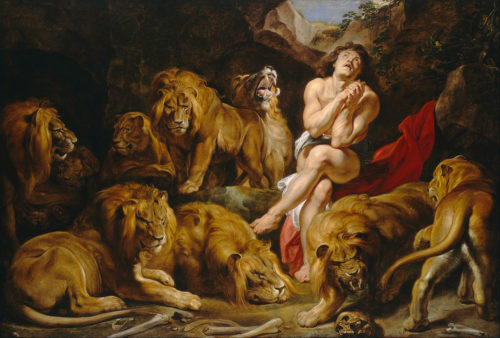
“Daniel in the Lions’ Den” by Peter Paul Rubens, c. 1615 (Wikipedia)
Treasured relics that are said to be the bones of the three young men are housed at the monastery of the Madonna of Montevergine, Italy. Since the 13th century, the Montevergine Madonna has been seen as a protector of queer people and processions to her shrine have been called “ancestral gay pride” marches. Their story is also vividly told in the hit country / gospel song recorded by the Statler Brothers and Johnny Cash, “The Fourth Man.”
The term “eunuch” included many sexual minorities
LGBTQ Bible scholars have examined the stories of Daniel and his friends in depth. The Bible describes them as slaves in Babylon at a time when castration of slaves was common. In contemporary usage a “eunuch” is a castrated man, but it had a broader definition in ancient times.

Daniel the Prophet by Lewis Williams. Prints available from Amazon and Trinity Stores
The Biblical category of eunuchs included a variety of sexual minorities and gender-variant individuals who today might be called queer or LGBT. These eunuchs may not have been “gay” or “transgender” in the contemporary sense, but they were sexual outcasts in the ancient world.
Literally meaning “the keepers of the bed,” the eunuchs served and guarded the women in royal palaces and wealthy households. Their employers wanted to be certain that the eunuchs would not get sexually involved with the women they were supposed to protect, so many eunuchs were castrated men, homosexual men, and intersex folk. Many, but not all, were both castrated and homosexual. Eunuchs were trusted officials who often rose to senior posts in government.
Jesus himself discussed eunuchs in Matthew 19:12: “There are eunuchs who were born that way.” The traditional interpretation of this scripture is that Jesus was speaking of voluntary celibacy, but LGBTQ people of faith are reclaiming it as affirmation.
Links related to Daniel
Ashpenaz the Chief Eunuch (Daniel 1), 2019 (Otherwisechristian.com)
Gay-Friendly Texts: Daniel and Ashpenaz (Lay Reader’s Book Reviews)
“Hebrew Boys: Portals of Faith” by queer black artist Genesis Tramaine is inspired by the Book of Daniel
To read this post in Spanish / en español, go to Santos Queer:
Daniel y los tres jóvenes: Dios rescata a los eunucos bíblicos, ofreciendo su apoyo a las personas LGBTQ de fe
Related links
Ethiopian eunuch: Early church welcomed queers in Bible story (Q Spirit)
Eunuchs (Transgender Christians)
“Born Eunuchs”: Homosexual Identity in the Ancient World (Faris Malik)
תפילת משיח קשת בענן (Rainbow Christ Prayer in Hebrew)
___
Top image credit:
“Daniel in the Lion’s Den” by Hans Thoma, 1886 (Wikimedia Commons)
___
This post is part of the LGBTQ Saints series by Kittredge Cherry. Traditional and alternative saints, people in the Bible, LGBT and queer martyrs, authors, theologians, religious leaders, artists, deities and other figures of special interest to lesbian, gay, bisexual and transgender and queer (LGBTQ) people and our allies are covered.
This article was originally published in December 2019, expanded with new material over time, and was most recently updated on July 20, 2024.
Copyright © Kittredge Cherry. All rights reserved.
Qspirit.net presents the Jesus in Love Blog on LGBTQ spirituality.

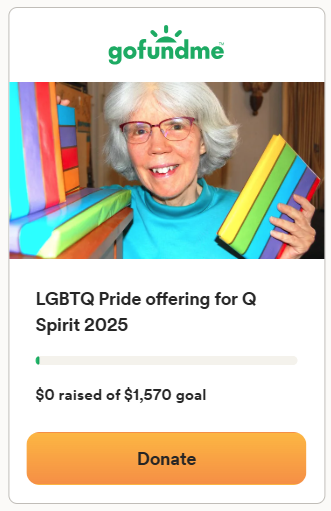
















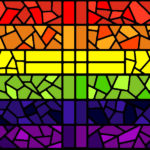

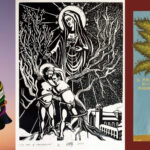

Samuel 1 18 1-3 says Johnathon and David’s love for each other exceeded their love of women. They made a covenant because they loved each other more than their own souls. This quote is one of the most same sex affirming in the Bible.
The reason why the translation “favor and tender love” is “hotly contested” is because it’s wrong. Claiming a homoerotic interpretation of someone trembling (in fear) at the sight of an angel is also contrary to context since the context here is simply that angelic beings are routinely described as inducing fear in humans (since they are described as glowing brightly in an unearthly manner and therefore startle people). And once again, you’re reinventing the term “eunuch” by claiming that the term included “homosexual men, and intersex folk”. That’s not the accepted definition.
If I am correct, you are stating that being Gay or part of the LGBTQ+ community is biblically accepted? I know of your background, however, what makes you think so? Can you provide details and evidence from the bible?! I would certainly appreciate your assertion.
Thank you and have a blessed day.
Scripture does not condemn loving, responsible homosexual relationships. There are many resources that fully explain the Bible and homosexuality. Here are a few that I recommend:
Theological resources from Metropolitan Community Churches
“What the Bible Really Says about Homosexuality” by Daniel Helminiak
“Radical Love: Introduction to Queer Theology” by Patrick Cheng
gaychurch.org
The Bible and Gays by Rev. Durrell Watkins
Getting easily obtainable icons for my second line of icons perhaps with a Mardi gras theme all year this chapel may become an oratory rather than a formal chapel possibly a pilgrimage site if the Madonna condescends to weep tears of grief for feminelli devotees and others